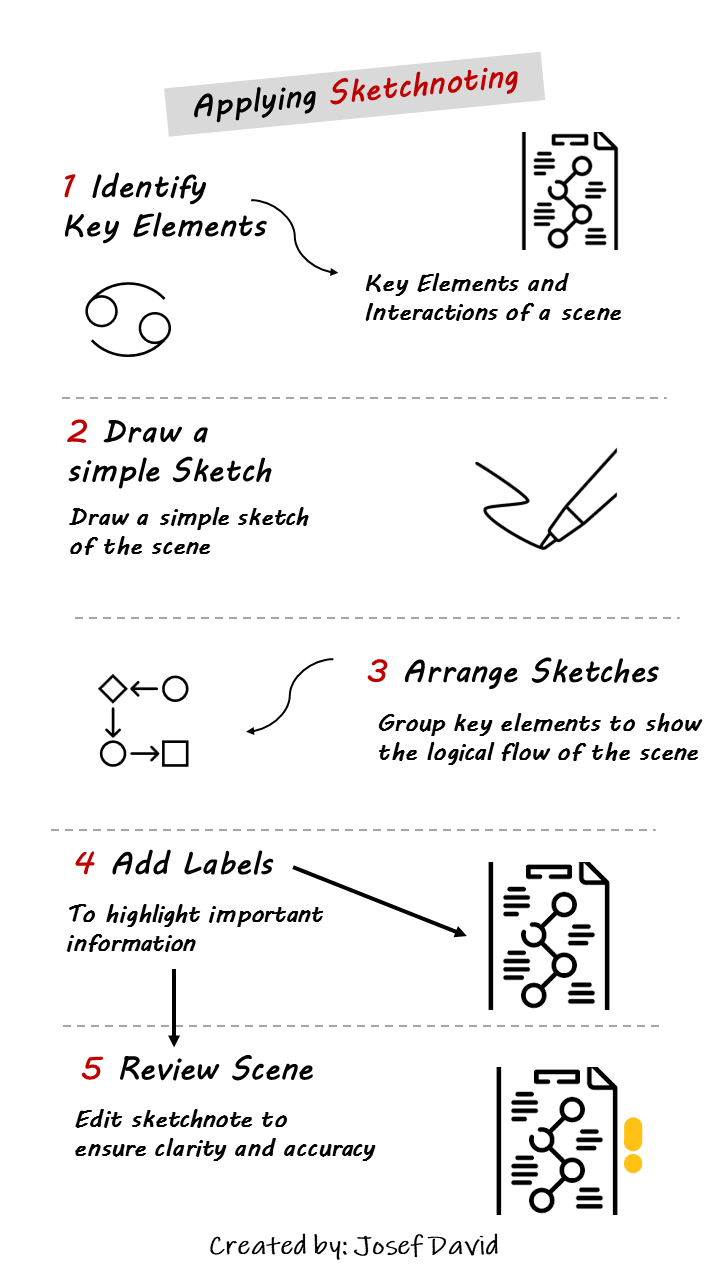What are Business Scenes?
Business scenes are essentially visual representations of various business scenarios or processes. They can depict anything from a company’s organizational structure, workflow processes, customer journey maps, to strategic planning and decision-making processes. These scenes provide a snapshot of the business’s operations, helping stakeholders understand the intricacies of the business model, identify potential bottlenecks, and devise strategies for improvement.
Why use Visual Thinking and Sketchnoting?
Visual thinking and sketchnoting are powerful tools that can greatly enhance our understanding and retention of information. They leverage our brain’s inherent ability to process visual information more efficiently than text.
Visual thinking involves using images, diagrams, charts, symbols, and other visual elements to represent information. It helps in simplifying complex ideas, identifying patterns and relationships, and facilitating problem-solving and decision-making.
Sketchnoting, on the other hand, is a method of note-taking that combines text with simple drawings and symbols. It not only makes note-taking more engaging but also aids in better recall of information.
In the context of business scenes, visual thinking and sketchnoting can be instrumental in:
1.Simplifying Complexity: Business processes can often be complex with multiple steps, roles, and dependencies. Visual representations can simplify these complexities making them easier to understand.
2. Enhancing Communication: Visuals are universal and transcend language barriers. They can effectively communicate ideas across diverse teams within an organization.
3. Facilitating Collaboration: Visuals can serve as a common ground for team members to discuss ideas, identify issues, and brainstorm solutions.
4. Driving Engagement: Visuals are more engaging than text-heavy documents. They can help in capturing attention and driving engagement among stakeholders.
How to sketch Business Scenes using Visual Thinking and Sketchnoting?
Creating business scenes using visual thinking and sketchnoting involves a few key steps:
1. Identify the Purpose: Understand what you want to achieve with the business scene. Is it to explain a process, communicate a strategy, or solve a problem?
2. Gather Information: Collect all necessary information related to the business scene. This could include data, processes, roles, dependencies, etc.
3. Create a Rough Sketch: Start with a rough sketch of the scene. Use simple shapes and symbols to represent different elements.
4. Refine and Detail: Add more details to your sketch. Use arrows to indicate flow or direction, use colors for differentiation or emphasis, add labels or annotations for clarity.
5. Review and Iterate: Review your sketch with stakeholders. Gather feedback and make necessary revisions.
Conclusion and Next Steps
Visual thinking and sketchnoting are powerful tools for creating business scenes. They not only simplify complex business scenarios but also enhance communication, collaboration, and engagement among stakeholders.
However, like any other skill, mastering visual thinking and sketchnoting requires practice. Start small – maybe by visually representing a simple process or meeting notes. Gradually move on to more complex scenarios as you get comfortable.
There are also numerous resources available online – books, courses, tutorials – that can help you learn and improve these skills.
Remember, the goal is not to create artistic masterpieces but to communicate effectively. So don’t worry about your drawing skills; focus on the message that you want to convey.
In conclusion, in an increasingly complex business environment, visual thinking and sketchnoting can be game-changers. They can help business leaders visualize their operations, strategies, and ideas – driving better understanding, decision-making, and results.

